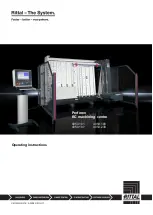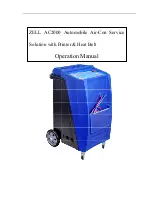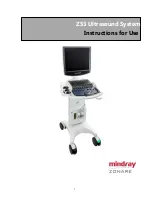
2 Safety instructions
Rittal Perforex BC machining centre
9
EN
that no ambiguous competencies with regard to safety occur. Basic re-
quirement for operating persons is the safe handling as well as experience
with computers and the deployed operating system.
– The operating company and all operators are obliged to ensure orderliness
and cleanliness at the workplace, in the work environment and the sur-
rounding passages.
Note:
Assembly, commissioning and operation, disassembly, mainte-
nance (including servicing and care) as well as disassembly and
disposal require basic mechanical and electrical knowledge as
well as knowledge of the associated technical terms
– In order to ensure operational safety, a corresponding specialist or an
instructed person under the supervision of a specialist may therefore
only carry out these activities.
2.4 Personal safety equipment
The operating and maintenance personnel must always wear personal pro-
tective equipment for all work on the Perforex BC machining centre. The per-
sonal protective equipment comprises of at least the following components:
– Safety work shoes: for all work on the machine.
– Gloves: when loading and unloading the machine, as well as when debur-
ring workpieces.
– Hearing protectors: when machining workpieces on the machine.
– Safety goggles: for cleaning work and when deburring workpieces.
2.5 Residual dangers when using the Perforex BC machining
centre
Despite the inherent safe design, the safety precautions and the supplemen-
tary protective measures, residual dangers remain.
In particular, the following situations require increased attention by the oper-
ator:
– The machining of workpieces that do not conform to the proper use (see
section 3.2 "Proper use, foreseeable misuse").
– The machine can normally be operated by one person. If the machine
should be operated by two or more persons, the operator on the operator
console has particular duty of care.
– There is the risk of being cut at the machined edges of the workpiece
when gloves are not worn (personal protective equipment).
– There is the risk of injury caused by the hot workpiece or tool.
– There is the risk of being hit by the braking gantry in the event of inadvert-
ent entry in the front safety area.
– There is the risk of being cut by loose workpiece swarf when cleaning the
machining centre.
– There is the risk of being injured by the high component weight and dimen-
sions during transport (also inner-plant), mounting and installation.
– There is the risk of being injured (crushing, impact) when clamping and
placing the cube (the enclosure) in the clamping device.
– There is the risk of being injured (shock, impact) by components under
pressure and the sudden movement or detachment of a part (e.g. the
bursting of a pneumatic hose under pressure).
– There is the risk of being injured by freed compressed-air components
(such as hoses and couplings that move to and fro under pressure).
– There is the risk of being injured by particles escaping with compressed air
(at open places in the compressed-air system).










































